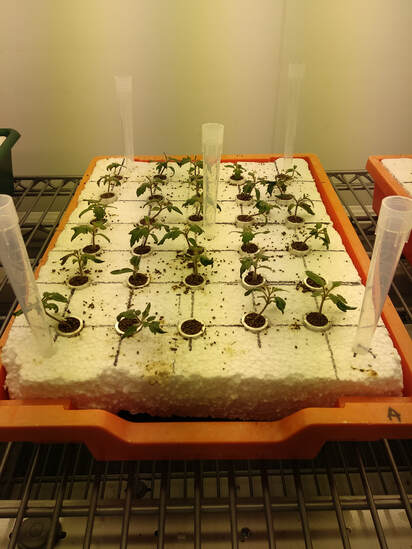|
For most of us, soil is just an amorphous brown mass. But this subterranean world teems with microorganisms; some benevolent and others downright nasty. Establishing the right microbial community in the rhizosphere – the area of soil immediately surrounding plant roots – can make the difference between a healthy harvest and a diseased, impoverished crop. But we still don’t understand what conditions cultivate a favourable ‘root microbiome’. With support from the STFC Food Network+, Xavier Portell-Canal and his colleagues (Prof Kai H. Luo, Dr Carol Verheecke-Vaessen, Prof Wilfred Otten, and Dr Genoveva Burca) hope to shine a light on this secret world.  Tomato plants growing in aluminium tubes to be imaged in ISIS and Diamond (Photo credit: Xavier Portell-Canal) Tomato plants growing in aluminium tubes to be imaged in ISIS and Diamond (Photo credit: Xavier Portell-Canal) “Root microorganisms provide valuable services to plants, including drought tolerance and protection against pathogens” says Xavier, an agronomist at Cranfield University. It’s thought that plant actively recruit specific microorganisms by changing the profile of chemicals secreted by their roots in response to different stresses. Exploiting these relationships could therefore help achieve the goal of increasing agricultural production without resorting to more chemical inputs. Certain companies already offer formulations of microorganisms to apply to crops, but these have limited effectiveness since we still don’t really understand what qualities make an optimal rhizosphere. Xavier intends to investigate this, looking at both the physical properties of the soil and the characteristics of the microorganisms. “At the moment, we don’t really know what qualities allow microorganisms to reach the rhizosphere and colonise there” he says. But trying to establish this through physical experiments is challenging, since it is almost impossible to take soil samples without disturbing the plant roots and surrounding soil. Consequently, Xavier is using a modelling approach, built on techniques he formerly used to study the growth of Saccharomyces cerevisiae, the yeast used in fermentation. “Our intention is to construct a highly accurate physical model of the rhizosphere and then populate this artificially with microorganisms that have different traits, to see which ones establish most effectively” he says. “We can then use this knowledge to identify the individual species most likely to be important for a good rhizosphere”. To build a 3D model of the physical soil structure, Xavier will use sophisticated, non-destructive imaging techniques that leave plant and soil samples intact. These include X-ray and neutron imaging, both of which are based on passing a beam through the sample that is altered depending on the sample’s composition. Whilst X-rays will be used to characterise the physical architecture, neutron imaging will map the distribution of water surrounding the root. To model the movement of water and chemical species, Xavier will use a computational method called Lattice-Boltzmann modelling, which simulates the reactions that occur on heterogeneous surfaces. With so many factors, the task of integrating the data into a single model will be far from easy. “Because the rhizosphere has so much physical, chemical and biological complexity, and lots of mechanisms playing a role, it is going to be a real challenge to bring this together in a multi-parametric system” Xavier says. “For instance, even the amount of mucilage around a plant root can dramatically alter the physical environment”. Once the physical and chemical environment is constructed, the next step will be to populate it with simulated microorganisms. Individual microorganisms will be given different levels of certain traits, such as growth rates, mobility, enzyme production and metabolic rate. “Once we know the general characteristics of successful colonisers, we can use information from published databases to identify the most likely microbial species” Xavier says. Ultimately, this could allow microbiologists to select beneficial microorganisms more likely to colonise the rhizosphere and provide the intended services to the plant, boosting crop productivity. Although this goal will take time to reach, Xavier is excited by the journey since it will allow him to use some of STFC’s most impressive facilities, including the Diamond Light Source synchrotron (for X ray analysis) and the ISIS Neutron and Muon Source (for neutron imaging). “With the funding from the STFC Food Network+, I was able to develop a network of experts that work on these facilities” he says. “Through our meetings, we developed the research proposal and successfully applied for beamtime on these facilities. We intend to use these experiments to generate preliminary data that will give us a stronger case to attract further funding”. “Recently, we have really become aware that soils are central to a number of issues of great societal concern, such as climate change, environmental pollution and feeding the growing world population. I am very grateful to the STFC Food Network+ because this project has allowed me to work on such an important issue using techniques and facilities I wouldn’t have accessed otherwise” Xavier concludes.
0 Comments
|
AuthorJune 2024 - Archives
June 2024
Categories |
- Home
- Webinars and Events
- About the SFN+
- News
- Blog
- Expert Working Groups
- Funding
-
Publications
- Bioeconomy positioning paper
- SFN+ 5th Annual Conference
- OMM Policy Report
- ‘Multi-Stakeholder International One Day Workshop on Organic Agri-Food Value Chains for Net Zero’ Report
- SFN 2050 UK Net Zero Food report
- Sustainable Cold Food Chain Booklet
- Food Sensing Technologies for Safe and Nutritious Food
- Sustainable urban and vertical farming
- Projects
- Join/Contact Us

 RSS Feed
RSS Feed


